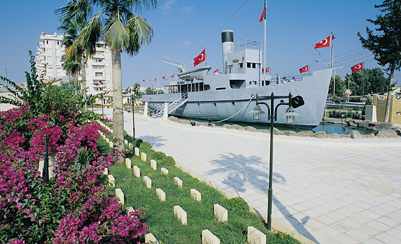Nusret Mine Ship is a Turkish naval vessel that played a critical role in the 1915 Gallipoli Campaign. In March 1915, the Nusret Mine Ship laid 26 mines, successfully preventing the British and French navies from passing through the Dardanelles Strait. This minefield led to the sinking of the battleships Bouvet, Irresistible, and Ocean, as well as severe damage to many other vessels, during the naval operations on 18 March 1915. With this achievement, Nusret became known as "the world’s most famous mine ship."

Nusret Mine Ship (Kültür Portalı)
Historical Background: Strategic Importance of the Dardanelles
The Ottoman Empire joined World War I in 1914 on the side of the Central Powers (Germany and Austria-Hungary). The Gallipoli Front was one of the war's most important theaters, and its geographic and strategic position made it vital for the Allied Powers. Their goal was to capture Istanbul, remove the Ottoman Empire from the war, deliver aid to Russia, and shorten the war’s duration.
To defend the strait, the Ottomans established numerous batteries, artillery positions, and minefields. However, the enemy navy's intelligence and reconnaissance capabilities threatened to bypass these conventional defenses. At this critical moment, Nusret executed an unseen yet deadly defensive maneuver.
Role of the Nusret Mine Ship
The Nusret Mine Ship served as a crucial strategic element to strengthen the defense of the Dardanelles. While several mine lines were deployed along the strait during preparations, the decisive action took place on the night of 7–8 March 1915. Nusret stealthily approached Erenköy Bay and laid the 11th minefield, consisting of 26 mines parallel to the shore. This minefield directly influenced the outcome of the 18 March operations, causing significant losses for the Allied Powers. The mines laid by Nusret became one of the foundations of the 18 March 1915 victory.
Technical Specifications and Armament of Nusret
Built in 1909 at the Schichau Shipyard in Kiel, Germany, the ship was purchased by the Ottoman Navy and entered service in 1913. Its main technical and structural specifications are:
- Length: 40 meters
- Width: 7.4 meters
- Draft: 2.8 meters
- Displacement: 365 tons
- Speed: 15 knots
- Propulsion: Two triple-expansion steam engines (total 800 HP)
- Armament: 2 × 47 mm guns
- Mine capacity: 40 mines
- Crew: Approximately 40 sailors
Its small size and shallow draft allowed maneuverability in shallow waters, especially enabling discreet nighttime operations.

Nusret Mine Ship Museum (AA)
The Night of 7–8 March 1915: A Strategic Move
On this pivotal night, the Nusret Mine Ship was tasked under the command of Cevat Pasha, commander of the strait. Under Captain Hakkı Bey, the ship exploited heavy fog and darkness to lay 26 mines at Karanlık Liman, one of the narrowest and least expected points in the strait.
The operation was carefully planned based on enemy vessel maneuver predictions and executed with precision. The mines were so strategically placed that enemy reconnaissance aircraft and submarines could not detect them. These mines contributed to the sinking of three major battleships and heavy damage to many others during the Allied Navy’s major assault on 18 March 1915:
- Bouvet (France): Sunk completely.
- HMS Irresistible (United Kingdom): Severely damaged and subsequently sank.
- HMS Ocean (United Kingdom): Sank while being salvaged.
Following this disaster, the Allied Navy suspended plans to pass through the strait by sea and shifted to a land campaign, making Nusret a key factor in altering the course of the Gallipoli Campaign.
Strategic Success of Nusret
The minefield laid by Nusret demonstrated not only the defensive strength of the Ottomans but also their strategic ingenuity. These mines, an unforeseen threat to the Allied Powers, forced the enemy fleet to retreat and significantly impacted the course of the battle.
Later Years and Historical Journey
After the war, Nusret served in different capacities within the Ottoman and later Turkish Navy. It remained active until 1955 and was decommissioned in 1973, subsequently sent to Mersin for scrapping. However, its fate changed.
In 1982, a group of volunteers and the Turkish Naval Forces restored the ship and moved it to Tarsus, where it was exhibited as a monument ship. While some original parts were lost during restoration, the vessel’s historical essence was preserved.
Cultural and Historical Legacy of Nusret
The Nusret Mine Ship symbolizes not only military success but also the strategic brilliance of the Turkish people. Naval Minister Winston Churchill described Nusret’s mines in 1930 as:
"Those twenty iron kettles dangling at the end of a fine steel wire, laid by the Turks, caused the death of so many men in World War I, led to enormous war expenses, and sank numerous merchant and warships."
Today, Nusret Mine Ship is displayed in a dedicated park in Çanakkale, attracting both local and international visitors interested in military history. A model of Nusret, restored to closely resemble the original, is also on display in the Çanakkale park.
Nusret Today: Museum and Memory Space
In 2003, the Turkish Naval Forces Command built a full-scale replica at Gölcük Shipyard and assigned it to the Çanakkale Naval Museum Command.
Thus, Nusret’s legacy continues in two locations: the original ship displayed on land in Tarsus and the museum ship launched in Çanakkale.

Nusret Mine Ship (Mersin İl Kültür ve Turizm Müdürlüğü)
Legacy of Nusret Mine Ship
Following the Gallipoli Campaign, Nusret remained an important military symbol. It was transported from Mersin to Tarsus by truck, covering 27 kilometers in 4.5 hours. After extensive research and restoration, the ship continues to be exhibited in Çanakkale Park. Detailed examination of its model, restored to closely match the original, provides insight into recreating this historic vessel at full scale.


